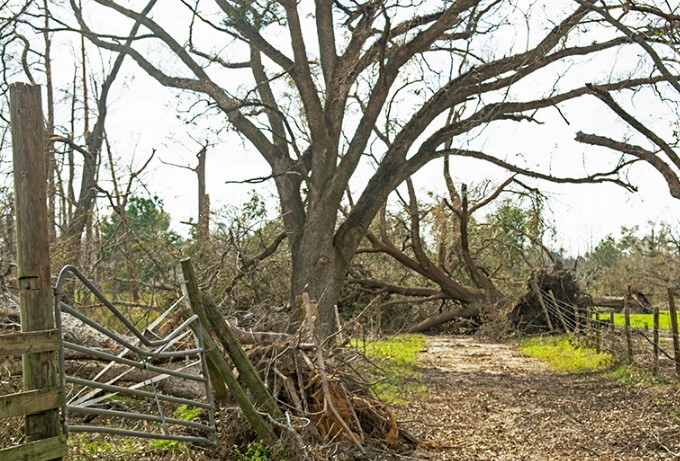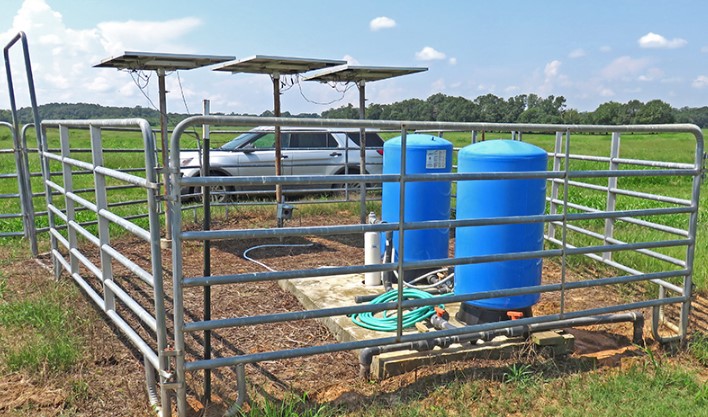By Doug Mayo
Regrettably, Hurricane Season is upon us once again, so Florida livestock producers need to start planning for the major hurricane that could make a direct hit on your ranch. I also know that disaster preparation is only one notch above succession planning, at the very top of your “Back-burner, I don’t have time for that right now list,” but both are extremely important when that terrible day eventually comes. Both also require significant advance planning to be effective. The main message is to develop a disaster plan for your livestock operation, before the panic starts when the storm is just offshore, and your farm is near the center of the dreaded cone.
Hurricane Michael caused major destruction to farms and ranches in the Florida Panhandle and South Georgia on October 10, 2018.
Hurricane Michael
Hurricane Michael blew through the Florida Panhandle with 130-160 mph winds that wrecked livestock operations in a 60-mile-wide path. By all accounts of the emergency responders, it was one of the worst disasters they had ever dealt with, because of powerful winds and the age and size of the trees that were destroyed. This area had not been hit by a major hurricane in over a hundred years. While almost every Floridian has some experience with tropical storms and hurricanes, there is a huge difference when you are in the direct path of a 130+ mph major hurricane. Farms and ranches in the Panhandle were without power for at least a month. Roads were completely blocked for days to weeks by downed trees. For many of the cattle operations in the impact zone, it took several days just to gain vehicle access to their cattle, and when they finally got around to their pastures, most were horrified at the mess they encountered.

Beautiful, large shade trees in fence-lines became a horrific mess to restore after Hurricane Michael, in Jackson County.
Trees in Fence Lines
For years many ranchers in the Southeast have relied on fence line trees for shade, which frees up the interior of a pasture for maximum sunlight for forage production. While this has been a practical management solution, it will become a nightmare after a major hurricane. Huge trees in fence lines will be uprooted, taking out large sections of fences. Even worse are those stretches of fences through low areas, where cypress, bay and other trees will create a tangled mess of fence, in water left standing after the storm. What you will face will not be a quick patch job to fill a few holes in the fence. Instead, it will take heavy equipment and chainsaw crews to clear debris, so that perimeter fences can be patched to keep livestock in. You may be forced to move your herd to small, interior pastures, traps, or pens that can be more quickly be restored. Many of these emergency fields, or traps, do not have access to a natural water source, so without electricity for well water, this creates another major issue to be dealt with. In addition, most hay, feed, and equipment barns, tubes of baleage, and other infrastructure will be severely damaged or destroyed.
There is no way to fully prepare for major devastation of this type in advance, but there are steps you can take to make your ranch more storm-ready. A significant portion of this nightmare can be avoided, if perimeter fence lines are kept free from brush and tree growth. Brent Sellers and Jay Ferrell, UF/IFAS Weed Specialists, have nice publications entitled,
Weed Management in Fence Rows, and
Weed Management in Rights-of-Way and Non-Cropped Areas, that provide an overview and basic recommendations for herbicide options for controlling trees and brush in fence-lines. However, there are no magic sprays to eliminate years of neglect. The strongest of the herbicide options will also kill oak trees, so you really must be careful to develop the best plan for your operation.
Shade is essential for heat stress management in Florida livestock production. Healthy live oak trees can survive a major hurricane, so, I am not saying every single tree should be eliminated from the fences on your farm. You may decide to leave some select “majestic oaks,” because isolated trees can be more easily fenced around than an entire fence line. However, the vast majority of your perimeter fences, especially those along highways, should be maintained annually with herbicides to remain free of brush and trees. Selecting the best options for your specific situation will require some level of consultation with your
county extension agent, weed specialist, and chemical dealer in order to develop the most economical solution. The key point here is to start eliminating as many trees as possible from your perimeter fence lines, before the next major storm comes ashore.
–
Water with No Electricity
As mentioned earlier, another key issue will be adequate water for your herd without electricity for your wells. Watering livestock in water troughs has been a recommended, best management practice for a number of years. But when the power is out for weeks at a time, this becomes a major concern. Hauling water from off the farm should be the last resort. Plus, the only water available to fill tanks will be from a municipal source powered by a generator in town or a fire truck. You need a generator strong enough to operate your wells, or at least one that can be transported from well to well to regularly refill all of the required water troughs. Another option would be to install a solar well on the farm in a central location. Of course, the old reliable system of stock ponds is also an option for emergency water, but they can be expensive to dig, and will reduce the acreage available for forage production.

Solar livestock wells, such as this one in Jackson County, can provide emergency water when there is no power, provided the solar panels are removed prior to the hurricane, and reinstalled soon afterwards.
Fence Supplies and Debris Removal
Every ranch needs to develop an emergency supply of fencing materials, and access to debris removal machinery to be used on the farm. Hurricanes can ramp up from a tropical depression to major hurricane in just a few days. There will be limited time to prepare in advance of an impending storm. After the storm passes, ag supply dealers may not reopen for weeks until power is restored. Metal T-posts, wood posts, fence staples, gates, and wire will not be available to purchase. Once your local stores finally reopen, available supplies will be gobbled up very quickly, due to the high demand. Chain saws, extra chains, mixing oil, and bar oil will also be articles in very high demand immediately before and after the storm, so those are also items that need to be purchased well in advance.
In addition to the generators mentioned earlier, another big ticket item worth considering is a front end loader and a grapple for your tractor, or even better, a skid steer loader with a grapple for moving large trees. A tractor, chain, and chainsaw are not adequate for getting huge trees out of the way quickly to repair fences. The goal is to be able to drag debris out of the way as fast as possible, so the fence can be patched, and then come back later to pile and burn the debris.
None of these things are inexpensive. The point is to come up with a plan and start making purchases in advance. Start with 20-50 fence posts, several roles of barbed wire, chainsaws and supplies. Then consider the larger ticket items such as a generator and debris moving equipment. You don’t want to spend up your savings making preparations right before the storm, because it will be needed for the slow recovery process. In 2019, many items need for disaster preparation can be purchased without sales tax from May 31-June 6. For information on what items qualify, use the following link:
2019 Disaster Preparedness Sales Tax Holiday
Another big ticket item worth considering is a front end loader and a grapple for your tractor, or even better, a skid steer loader (as seen above) with a grapple for moving large limbs and trees away from fences.
Preparation for a Major Hurricane
My hope is that you can benefit from the hard lessons learned in the Panhandle in 2018. Ranchers need to develop their own emergency response plan for a major hurricane. This plan should include: 1) chemical tree and brush control along perimeter fences; 2) an emergency interior pasture large enough for the entire herd; 3) an emergency water source: pond, solar pump, or generator for electric wells; 4) emergency fence repair supplies; 5) at least enough hay or feed your herd for several weeks in more confined areas; 6) extra chain saws and supplies; and 7) some type of debris removal equipment. These steps will not eliminate all the hardships following a major hurricane, but they will certainly help each ranch be more self-sufficient. Once livestock are secured, watered, and fed you will at least be able to slow down enough to plan the slow recovery process.